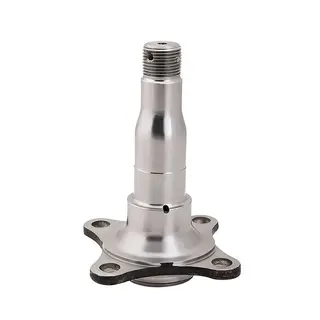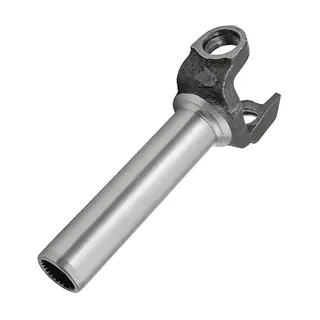In the field of metal processing, the control of grain size has always been a key factor affecting product quality. Grain size not only determines the microstructure of materials but also directly affects their mechanical properties, durability, and service life. This article will explore the importance of grain size, influencing factors, and how to optimize grain size through reasonable forging and heat treatment processes to improve the overall performance of metal materials.
Grain size refers to the size of grains within crystals, usually expressed as the average grain area or average diameter. In industrial production, grain size is typically measured by grain size grades. In general, the finer the grains, the better the material properties. Fine-grained materials possess higher strength, toughness, and fatigue resistance, making them highly favored in high-demand fields such as aerospace, automotive manufacturing, and mechanical engineering.
Forging is a processing method that changes the shape and size of metals through plastic deformation. During forging, changes in grain size have a profound impact on material performance. The following are several key factors influencing grain size in forging:
During plastic deformation, coarse primary dendrites in the forging are broken, achieving grain refinement. This process is crucial for improving the plasticity and toughness of materials. For example, during high-temperature plastic deformation, the grain size of the forging changes due to recrystallization. The recrystallized grain size is mainly determined by temperature, deformation degree, and deformation rate. Different forging processes result in different grain size outcomes.
Forging temperature is one of the key factors affecting grain size. Generally, the higher the forging temperature, the larger the recrystallized grain size of the forging. Therefore, under conditions that prevent low-temperature forging cracks, the final forging temperature should be minimized to achieve grain refinement. However, for large forgings, ensuring that all regions adopt the same low final forging temperature is very difficult, relying on the experience and skill of the forge operator.
During forging, there is a critical deformation range. When the deformation degree falls within this range, the recrystallized grain structure will be relatively coarse. Therefore, during forging, especially during the final heating pass, the deformation degree should avoid the critical deformation range to ensure uniform grain refinement.
Grain inhomogeneity refers to areas in a forging where grains are particularly coarse, while other areas are smaller. This inhomogeneity reduces the durability and fatigue performance of the forging. The main causes of uneven grain size include uneven billet deformation, localized deformation within the critical deformation range, local work hardening of high-temperature alloys, or coarse grains during quenching or heating. Heat-resistant steels and high-temperature alloys are particularly sensitive to grain inhomogeneity, so special attention must be paid to controlling the forging process to avoid it.
Heat treatment is a process that changes the microstructure of metal materials by controlling heating and cooling, thereby optimizing performance. Heat treatment plays an important role in eliminating coarse grains but requires precise measures according to different material characteristics and process defects.
For large low-alloy steel forgings (such as 30Cr2Ni4MoV), coarse grain problems often originate from the inheritance of non-equilibrium structures (bainite/martensite). The three-stage normalizing process is an effective solution:
First Normalizing: Heat the forging at ≤150°C/h to 50–100°C above Ac3 (e.g., 870–920°C), holding time t=k×D (k=0.8–1.5 min/mm, D = effective thickness), followed by air cooling + spray forced cooling to 300±10°C. This stage fully austenitizes the material and breaks the orientation of the original grain boundaries.
Second Quenching: Heat to Ac3+80–120°C and water quench. Phase transformation stress induces recrystallization and eliminates residual austenite substrate.
Third Normalizing + Tempering: Conduct isothermal normalizing in the Ac1–Ac3 two-phase region, combined with tempering at 560–600°C, stabilizing grain size to grade 5 or above. For example, applying this process to a nuclear power rotor improved the inspection pass rate from 65% to 92%.
For medium-high hardenability steels (such as 26Cr2Ni4MoV), conventional normalizing cannot eliminate inherited structures, requiring high-temperature normalizing to trigger austenite recrystallization:
High-Temperature Normalizing: Heat the forging 150–200°C above Ac3 (e.g., 1050–1100°C), holding time calculated as cross-section × 1.2h/100mm. In a high-temperature environment, the energy barrier for austenite grain boundary migration is reduced, and internal stress from volume expansion drives recrystallization, producing new grains uncorrelated with original coarse grains. For example, a turbine shaft forging treated at 1040°C × 8h improved grain size from grade 2 to 4.5, and the elimination rate of strip segregation reached 80%.
Gradient Cooling Process: First air cool to 650°C, then slow furnace cool to avoid secondary coarsening. This method is particularly effective for ultra-large forgings with diameters >2000mm.
For martensitic steels with strong inheritance tendencies (such as 2Cr12NiMo1W1V), rapid heating in the critical zone can effectively block grain inheritance:
Rapid Heating: Heat coarse forgings ≥370°C/h to Ac1+30–50°C (e.g., 750–780°C), hold briefly (10–15 min/mm), then oil quench. Rapid heating suppresses plate-like austenite nucleation and promotes spherical austenite-dominated transformation.
Subcritical Annealing: Temper at 690±10°C × 4h to precipitate carbides uniformly. For an aerospace valve disc, the mixed grain ratio decreased from 35% to below 5%, and the grain size reached ASTM grade 5. This process requires precise heating rate control, with temperature accuracy ±5°C.
Aluminum alloy forgings, with excellent properties such as light weight, high strength, and corrosion resistance, are widely used in aerospace, automotive, and mechanical manufacturing. However, coarse grains can occur during the preparation process, affecting not only the appearance but also mechanical properties and service life. The formation of coarse grains in aluminum alloy forgings is a complex process involving multiple factors.
The chemical composition, grain size, and distribution of aluminum alloys all affect coarse grain formation. Uneven alloying or large grain size can lead to coarse grains during forging. In addition, the smelting and casting process can also affect coarse grain formation. Improper smelting temperature or uneven cooling during casting can cause coarse grains inside the aluminum alloy.
Forging process parameters are critical for coarse grain formation. Forging temperature, speed, and reduction ratio directly influence grain size. Excessively high forging temperature can cause grain growth and coarse grains. Too fast forging speed can prevent sufficient grain refinement. The choice of reduction ratio also affects grain size; too low a ratio causes insufficient deformation, and too high a ratio, although promoting refinement, may cause internal stress concentration, affecting performance.
Unreasonable die design, such as complex cavity structure or small fillet radii, can hinder aluminum flow in the die, causing localized coarse grains. The die material and surface finish also affect metal flow and deformation, influencing grain size.
Heat treatment temperature, holding time, and cooling rate all directly affect grain size. Excessive heat treatment temperature or too long holding time can cause grain growth, while overly rapid cooling can generate large internal stresses, resulting in coarse grains.
To control coarse grains in aluminum alloy forgings, the following measures can be taken:
Optimize smelting and casting processes to ensure uniform chemical composition and fine grains.
Reasonably select forging parameters to control temperature, speed, and reduction ratio to refine grains.
Strengthen die design and manufacturing quality control to ensure reasonable structure and smooth surface, reducing resistance to metal flow.
Optimize heat treatment processes, reasonably controlling temperature, holding time, and cooling rate to further refine grain size.
Grain size control is of great significance in metal processing. Through reasonable forging and heat treatment processes, grain size can be effectively optimized, improving the mechanical properties and service life of metal materials. In actual production, process parameters should be selected according to material characteristics and process requirements to achieve uniform grain refinement. For special materials such as aluminum alloys, particular attention must be paid to optimizing smelting, casting, forging, and heat treatment processes to ensure high-quality final products.



